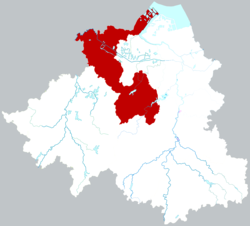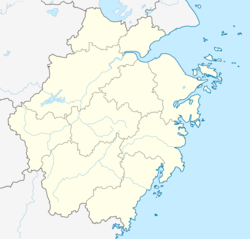This article needs additional citations for verification. (September 2021) |
Keqiao District (simplified Chinese: 柯桥区; traditional Chinese: 柯橋區; pinyin: Kēqiáo Qū), formerly Shaoxing County, is a district of the city of Shaoxing in Zhejiang province, China.
Keqiao
柯桥区 | |
|---|---|
 Ke Bridge (柯桥) | |
 Location in Shaoyang | |
| Coordinates: 30°04′55″N 120°29′41″E / 30.08194°N 120.49472°E | |
| Country | People's Republic of China |
| Province | Zhejiang |
| Prefecture-level city | Shaoxing |
| Area | |
| • District | 1,040 km2 (400 sq mi) |
| • Urban | 77 km2 (30 sq mi) |
| Time zone | UTC+8 (China Standard) |
| Website | www |
The Keqiao section of the Eastern Zhejiang Canal is one of the best preserved, having historic bridges of the ancient towpath.[2]
Geography
editKeqiao District, located in the south of Yangtze Delta, meets Shanghai in north, Hangzhou in west and Ningbo in east. It is 20 km (12 mi) from Xiaoshan International Airport, 230 km (140 mi) to Pudong International Airport and 150 km (93 mi) to Ningbo port. It has an area of 1,040 km2 (400 sq mi).[3]
Climate
edit| Climate data for Keqiao (1981−2010) | |||||||||||||
|---|---|---|---|---|---|---|---|---|---|---|---|---|---|
| Month | Jan | Feb | Mar | Apr | May | Jun | Jul | Aug | Sep | Oct | Nov | Dec | Year |
| Mean daily maximum °C (°F) | 8.3 (46.9) |
10.4 (50.7) |
14.8 (58.6) |
21.1 (70.0) |
26.3 (79.3) |
28.9 (84.0) |
33.6 (92.5) |
32.4 (90.3) |
27.7 (81.9) |
22.9 (73.2) |
17.4 (63.3) |
11.2 (52.2) |
21.3 (70.2) |
| Mean daily minimum °C (°F) | 1.7 (35.1) |
3.4 (38.1) |
6.9 (44.4) |
12.4 (54.3) |
17.7 (63.9) |
21.6 (70.9) |
25.5 (77.9) |
25.1 (77.2) |
20.9 (69.6) |
15.1 (59.2) |
9.1 (48.4) |
3.3 (37.9) |
13.6 (56.4) |
| Average precipitation mm (inches) | 85.9 (3.38) |
86.6 (3.41) |
144.0 (5.67) |
125.0 (4.92) |
136.6 (5.38) |
199.6 (7.86) |
146.6 (5.77) |
176.0 (6.93) |
150.7 (5.93) |
79.5 (3.13) |
80.7 (3.18) |
58.7 (2.31) |
1,469.9 (57.87) |
| Source: National Meteorological Center of CMA[4] | |||||||||||||
Administrative divisions
editSubdistricts:[5]
- Keqiao Subdistrict (柯桥街道), Keyan Subdistrict (柯岩街道), Huashe Subdistrict (华舍街道), Hutang Subdistrict (湖塘街道), Qixian Subdistrict (齐贤街道), Fuquan Subdistrict (福全镇), Anchang Subdistric (安昌街道), Lanting Subdistrict (兰亭街道), Qianqing Subdistrict (钱清街道), Yangxunqiao Subdistrict (杨汛桥街道), Ma'an Subdistrict (马鞍街道)
Towns:[5]
Demographics
editKeqiao District contains 302 administrative villages, 70 neighborhood committees (community), and has a registered population of 714,600 and a non-registered population of 606,800.
Economy
editKeqiao District has experienced rapid economic and social development, and repeatedly entered the top ten counties. In 2008, the county's GDP reached 60.8 billion yuan with a growth rate of 8.8% from 2007, per capita GDP reached RMB 85,368 yuan (US$12,075); financial revenues reached 7.57 billion yuan, of which the local financial revenue 3.85 billion yuan, respectively, an annual increase of 13.0% and 17.5%, total fixed asset investment of 24.2 billion yuan, an annual increase of 12.9%, of which 14.1 billion yuan of industrial inputs, an annual growth of 0.2%; urban residents per capita disposable income reached 26,155 yuan, the per capita net income of farmers 13,372 yuan, respectively, the average annual growth of 12.5% and 12.6%.
The textile industry contributes a significant part to the local economy. Keqiao is one of the largest textile dyeing and printing bases in China.[8] It is also home to the China Textile City, a 3.65 million square metre marketplace with 29,000 sellers.[9]
Transport
editKeqiao District is served by Shaoxing Metro Line 1, which offers an interchange with Hangzhou Metro Line 5 at Guniangqiao station.
Tourist attractions
editThe district houses many ancient bridges, such as Taiping Bridge and Jiedu Bridge.[10]
References
edit- ^ "城乡建设".
- ^ "Shaoxing's towpath to history". SHINE. Retrieved 2021-09-18.
- ^ "柯桥简介". www.kq.gov.cn. Retrieved 2021-09-18.
- ^ 1981年-2010年(海城)月平均气温和降水 (in Simplified Chinese). National Meteorological Center of CMA. Retrieved 11 November 2022.
- ^ a b "2020年统计用区划代码". www.stats.gov.cn. Retrieved 2021-09-18.
- ^ "The Sindhis of Shanghai: how an Indian diaspora cracked China". South China Morning Post. 2018-09-15. Retrieved 2021-09-18.
- ^ Cheuk, Ka-Kin. "Indians in the Chinese textile city: middleman traders in upgrading economy." Emerging Scholars Symposium, Indian China Institute, The New School for Social Research. Vol. 2. 2012.
- ^ "Keqiao Profile". www.kq.gov.cn. Retrieved 2021-09-18.
- ^ Mukherjee, Sanjeeb (2016-08-29). "India's first textile city likely to come up in AP". Business Standard India. Retrieved 2021-09-18.
- ^ 绍兴古桥群. sx.gov.cn (in Chinese). 2020-07-22. Archived from the original on 2021-07-09. Retrieved 2023-02-17.
